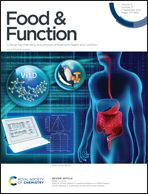Pine nut antioxidant peptides ameliorate the memory impairment in a scopolamine-induced mouse model via SIRT3-induced synaptic plasticity†
Abstract
This study aimed to investigate the effects of a pine nut albumin hydrolysate (fraction <3 kDa) and of its short peptide derivative, Trp-Tyr-Pro-Gly-Lys (WYPGK), on synaptic plasticity and memory function in scopolamine-induced memory-impaired mice, as well as the potential underlying mechanism in PC12 cells. In the scopolamine-induced mouse model, the results revealed that the fraction <3 kDa and WYPGK enhanced synaptic plasticity and improved learning and memory function. H&E and Nissl staining analysis showed that the damage in hippocampal neurons was decreased. Golgi staining and transmission electron microscopy further revealed that the enhanced synaptic plasticity was associated with increased dendritic spine abundance and synaptic density. In an H2O2-induced PC12 cell model, treatment with mitochondrial sirtuin 3 (SIRT3) inhibitor and inducer molecules confirmed that the <3 kDa fraction and WYPGK activated SIRT3, leading to the decrease in Ace-SOD2 acetylation and increasing the expression of SYP, SYN-1, SNAP25, and PSD95, thus enhancing synaptic plasticity. The <3 kDa fraction and WYPGK also activated the ERK/CREB pathway and upregulated the expression of brain-derived neurotrophic factor. Our results show that fraction <3 kDa and WYPGK improve learning and memory ability through SIRT3-induced synaptic plasticity in vitro and in vivo.



 Please wait while we load your content...
Please wait while we load your content...